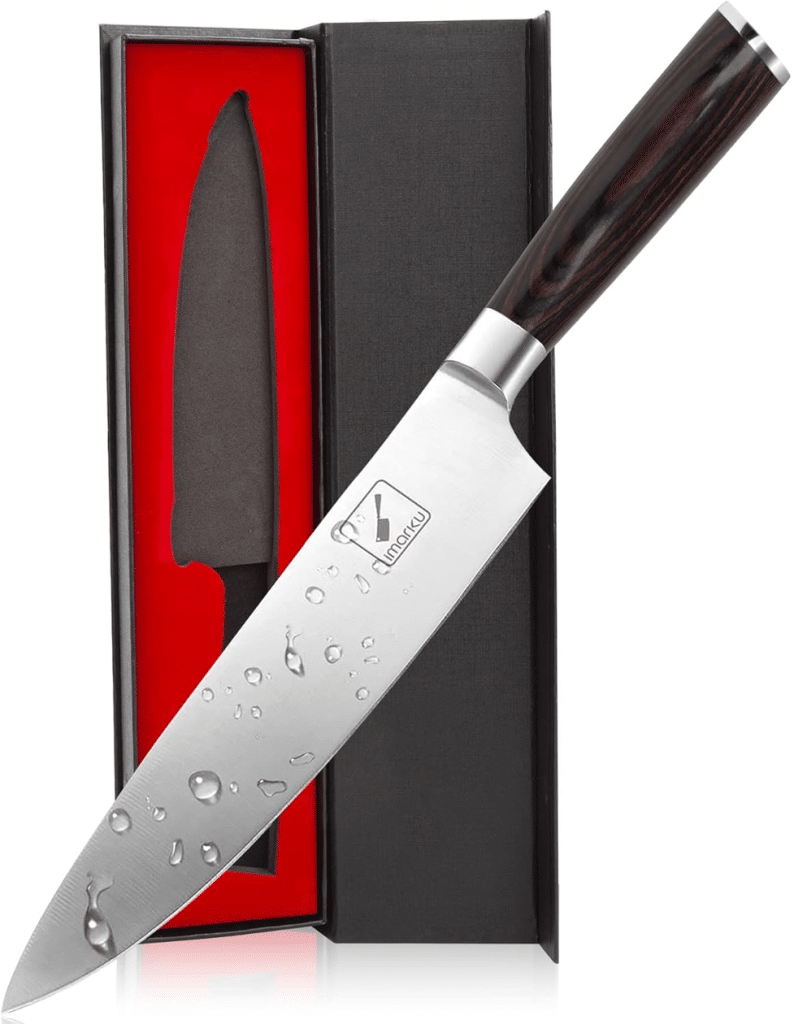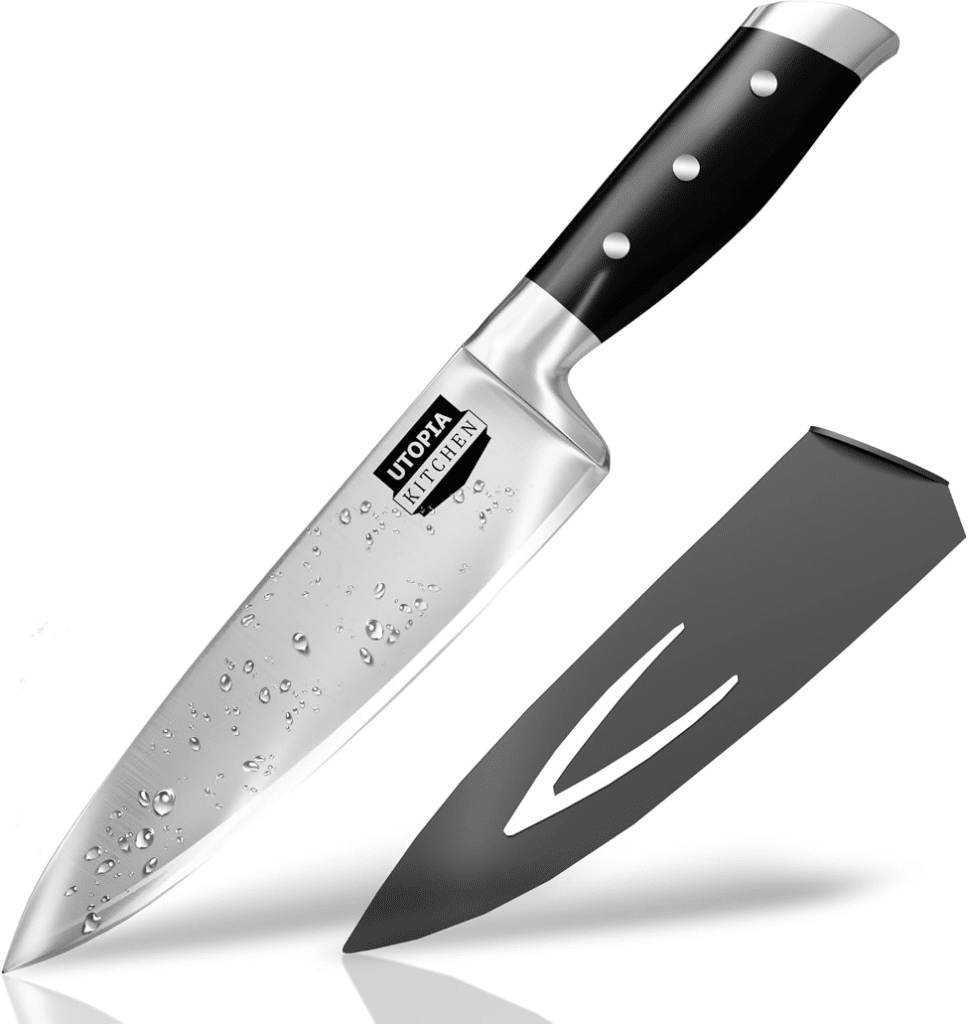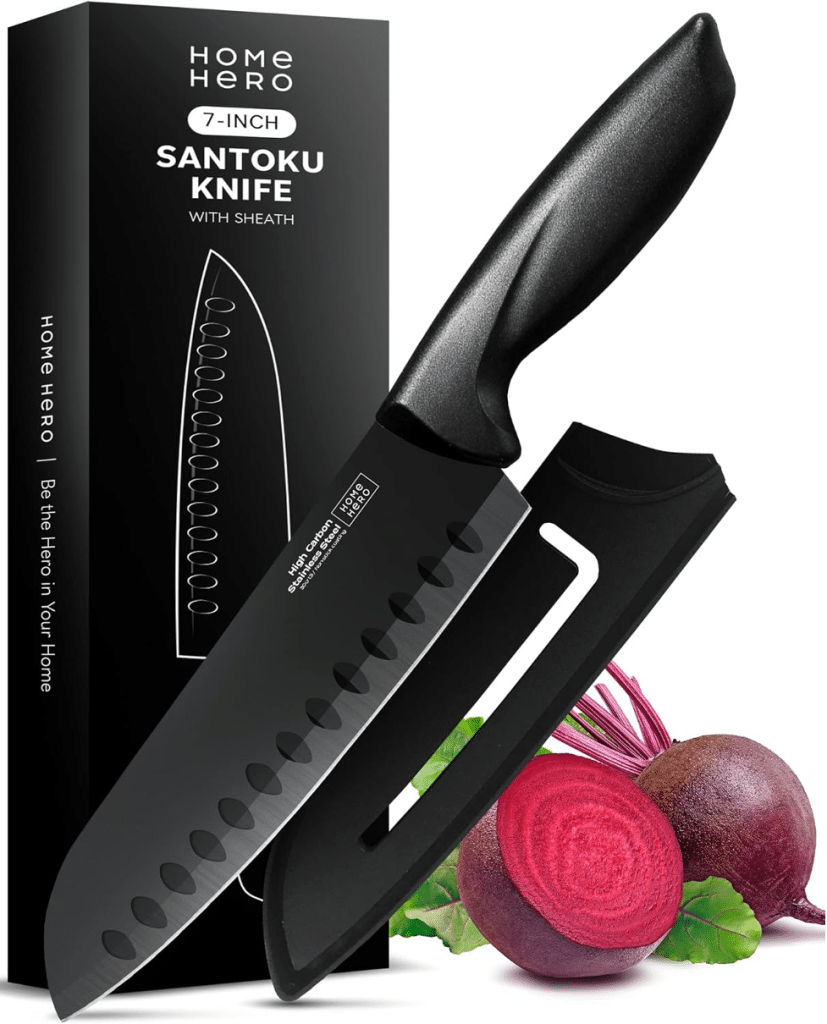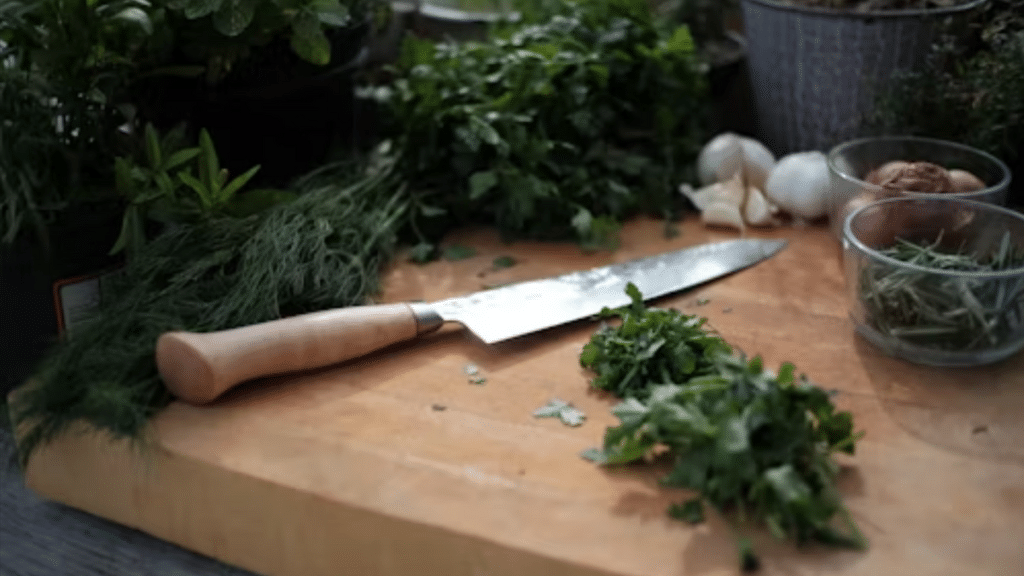The market is flooded with overpriced kitchen equipment, meaning that finding a chef knife under $30 that doesn’t feel like a toy can be challenging. Whether you’re outfitting a small apartment or just need a budget backup knife, there are still solid options on the market in 2025.
We’ve researched the top picks under $30 and what makes them actually worth buying, from build quality to edge retention and usability.
What to Expect From Sub-$30 Knives
Let’s be real – you’re not getting a Japanese VG-10 blade at this price point. But you can expect:
● Decent stainless steel that holds an edge through basic prep
● Full tang or partial tang designs that feel solid in hand
● Ergonomic handles that don’t cramp your grip
● Lightweight balance that suits casual cooking
These knives won’t last forever – but if you treat them well, they’ll absolutely punch above their price tag.
Our Top Picks for 2025
These are our top 3 picks for 2025, based on affordability, usability, practical use and real-world testing in a home kitchen.
1. Imarku 8” Chef Knife

Best overall performance under $30
The Imarku 8-inch chef knife consistently tops Amazon’s best-seller lists, and it’s easy to see why. It uses high-carbon stainless steel that holds an edge longer than most blades in this price range, giving it that rare combo of initial sharpness and moderate durability.
It’s also one of the few budget knives that actually feels balanced in the hand – thanks to a slightly curved bolster and decent weight distribution. The full-length ergonomic handle makes it comfortable for repetitive chopping, even for larger hands.
You’re not getting artisan steel here, but for under $30, it slices cleanly through onions, sweet potatoes, raw chicken, and even tougher cuts like butternut squash (with a bit of care). It’s an ideal daily workhorse for small households or beginners who want a real chef knife feel without overthinking it.
✅ Best for everyday use and anyone who wants one solid knife that can do it all.
2. Utopia Kitchen Chef Knife

Best value for a backup or starter knife
Utopia’s 8” stainless steel chef knife is about as no-frills as it gets – but that’s what makes it perfect if you’re just getting started or want a backup blade you don’t have to baby.
The steel is on the softer side, so it won’t hold its edge as long, but it’s easy to hone and surprisingly sharp out of the box. What stands out most is how comfortable and familiar the grip feels, especially for people upgrading from a grocery store set or an old, dull hand-me-down.
This is a fantastic knife to throw into your everyday rotation, keep at a second residence, or give as a gift to someone setting up their first kitchen.
✅ Best for students and anyone who just needs something sharp that works.
3. Home Hero 8” Stainless Steel Knife

Best design & ergonomics for beginners
The Home Hero looks more expensive than it is – sleek black styling, molded handle, and a nonstick blade coating make it one of the more “premium-feeling” knives under $30. But beyond the looks, it’s actually well-designed for ease of use and fatigue-free prep.
The lightweight build makes it easy to maneuver, and the soft-grip handle reduces wrist strain during longer sessions. While the nonstick coating can eventually show wear if you scrub too hard or dishwash it (don’t), it helps with sticky foods like potatoes and squash right out of the box.
Edge retention is average, but for most light-to-moderate cooking, it performs admirably. If you’ve ever been intimidated by “real” chef knives and want something friendly to use while learning — this one’s your guy.
✅ Best for beginners, and cooks who prioritize comfort and control.
What We Looked For
When curating sub-$30 options, we focused on:
● Blade material & sharpness retention
● Handle comfort during extended prep
● Durability with basic care (handwashing, honing)
● Balance and weight for non-pro use
You’ll often find that knives in this range are best when used for light to moderate cooking, not bone-chopping or professional kitchen volume.
Want Hands-On Testing & Real Use Cases?
We found that performance varied wildly depending on grip, handle material, and blade weight – especially over longer prep sessions. That kind of nuance doesn’t always show up in product specs, but it’s exactly what’s covered in this real-world review and knife breakdown we referenced during testing.
It covers performance comparisons, grip comfort over long sessions, and durability after weeks of daily use.
Maintenance Tips for Cheap Knives
Budget knives will dull faster – that’s a fact. But they can still last if you:
● Handwash immediately (never dishwashers)
● Dry with a towel right after rinsing
● Use a honing rod weekly to maintain the edge
● Store in a sheath or block, not loose in a drawer
A $25 knife treated well can outperform a $60 knife that is poorly treated.
How Chef Knives Compare: Budget vs Japanese vs Damascus
Let’s clear this up: “Japanese” and “Damascus” are styles and materials, not inherently superior categories.
| Type | Pros | Cons | Price |
| Budget Chef Knife ($20–$30) | Cheap, light, usable | Loses edge fast, synthetic handle | $20–30 |
| Japanese Knife (Gyuto, Santoku) | Razor-sharp, precise, lightweight | Brittle, needs care, expensive | $80–200+ |
| Damascus (Patterned Steel) | Strong, aesthetic, layered | Usually marketing BS under $50 | $60–300+ |
Chef Knife Specs to Watch (Even at $30)
If you’re shopping blind, here’s what to look for:
| Spec | What You Want |
| Blade Length | 7″- 8″ for chef knives |
| Steel Type | High-carbon stainless steel |
| Tang | Full tang = better balance & durability |
| Handle Material | ABS, Pakkawood, Polypropylene – avoid metal handles |
| Weight | Light-to-medium (150–250g ideal for beginners) |
We noticed in an independent kitchen gear review that lighter knives were more forgiving for casual cooks – especially when slicing softer produce or trimming meat.
How to Tell If a Budget Knife Is Actually Worth Buying
You’d be shocked how many sub-$30 knives are rebranded clones – same factory, different label, different price. Here’s how to spot the good ones:
● Amazon review velocity: A sudden spike of 5,000 reviews = likely faked
● Too many “sets” or bonuses: A knife that comes with 5 freebies is usually compensating for being junk
● Photoshopped Damascus patterns: If it looks like a Damascus blade but costs $25… it’s a print, not layered steel
Red flag: If the knife weighs less than 120g and claims to be “full tang,” it’s lying. At this price, transparency > gimmicks.
The Knife Most People Buy First (and Regret)
Cheap Santoku knives or “5-piece kitchen sets” are common traps.
Santoku-style blades (flat edge, sheep’s foot tip) are amazing – but not ideal for beginners. They don’t rock like a western chef knife, making them harder for fast chopping or curved motions. People buy them for the aesthetic, then switch back in frustration.
If you’re starting out, stick with a classic 8-inch Western chef knife. It’s the Swiss Army knife of blades.
What Can a $30 Knife Actually Handle?
Don’t let the price tag fool you. With decent technique, these knives can:
● Break down a whole chicken (with patience)
● Slice root vegetables like potatoes and squash
● Chop onions, tomatoes, garlic – no problem
● Handle 95% of prep for solo or family cooking
But don’t expect it to:
● Hold an edge after rough cutting bones or frozen foods
● Compete with premium knives on finesse or razor precision
● Survive the dishwasher more than a few times
In short: they’re tools, not trophies. Treat them like a utility blade, not a collector’s piece.
When It Is Time to Upgrade
Here’s when it makes sense to jump to a $70–$150 knife:
● You’re cooking 5+ days per week and notice grip fatigue
● You want better edge retention to avoid sharpening every 2 weeks
● You’re slicing a lot of raw meat, sushi, or precision cuts
● You’ve learned your ideal blade shape and weight
Until then? A $25 knife that feels good in your hand and doesn’t suck is a perfect launch point.
Final Thoughts
You don’t need to drop $100 to get a decent blade in your hand. If you’re cooking for one, outfitting a starter kitchen, or just need a backup knife, these budget picks deliver functionality without breaking the bank.
❓FAQs About Budget Chef Knives
Are knives under $30 actually safe to use?
Yes – as long as you avoid knockoff brands and sharpen them regularly. A dull knife is actually more dangerous than a cheap one because it forces you to use more pressure and can slip. Stick to well-reviewed, high-carbon stainless steel models and handwash them to keep them in good shape.
Can I put these knives in the dishwasher?
Technically? Some say yes. Realistically? Don’t. Dishwashers dull the edge, corrode rivets, and warp handles over time. If you care even a little about longevity, rinse and wipe by hand. It takes 10 seconds and can add months of usable life.
How often do I need to sharpen a cheap chef knife?
With regular use, expect to hone it weekly and sharpen it every 1–2 months. Cheap knives dull faster because the steel is softer. A $10 honing rod can keep it slicing clean between real sharpenings.
What’s the difference between a chef knife and a Santoku knife?
A chef knife usually has a curved blade suited for rocking motions – think slicing herbs or dicing onions. Santoku knives have a flatter edge and work best for straight downward cuts. If you’re a beginner, a standard 8” chef knife is more forgiving and versatile.
Is it better to just spend more upfront on a quality knife?
Eventually, yes – but not until you know what you like. Most people can’t tell the difference between a $25 knife and a $90 knife without daily experience. Start cheap, figure out your preferences (handle thickness, blade weight, balance), then upgrade intelligently.
